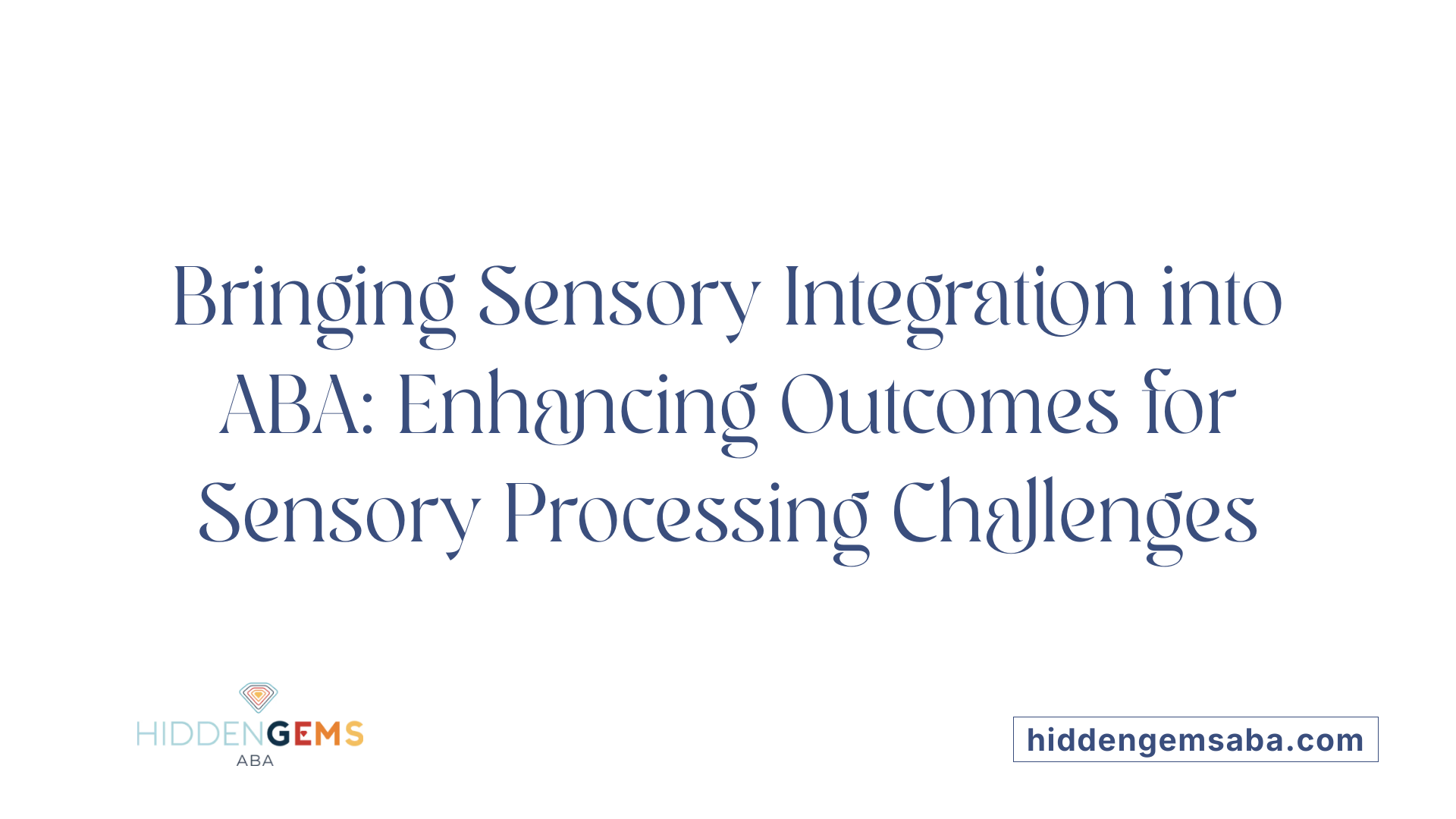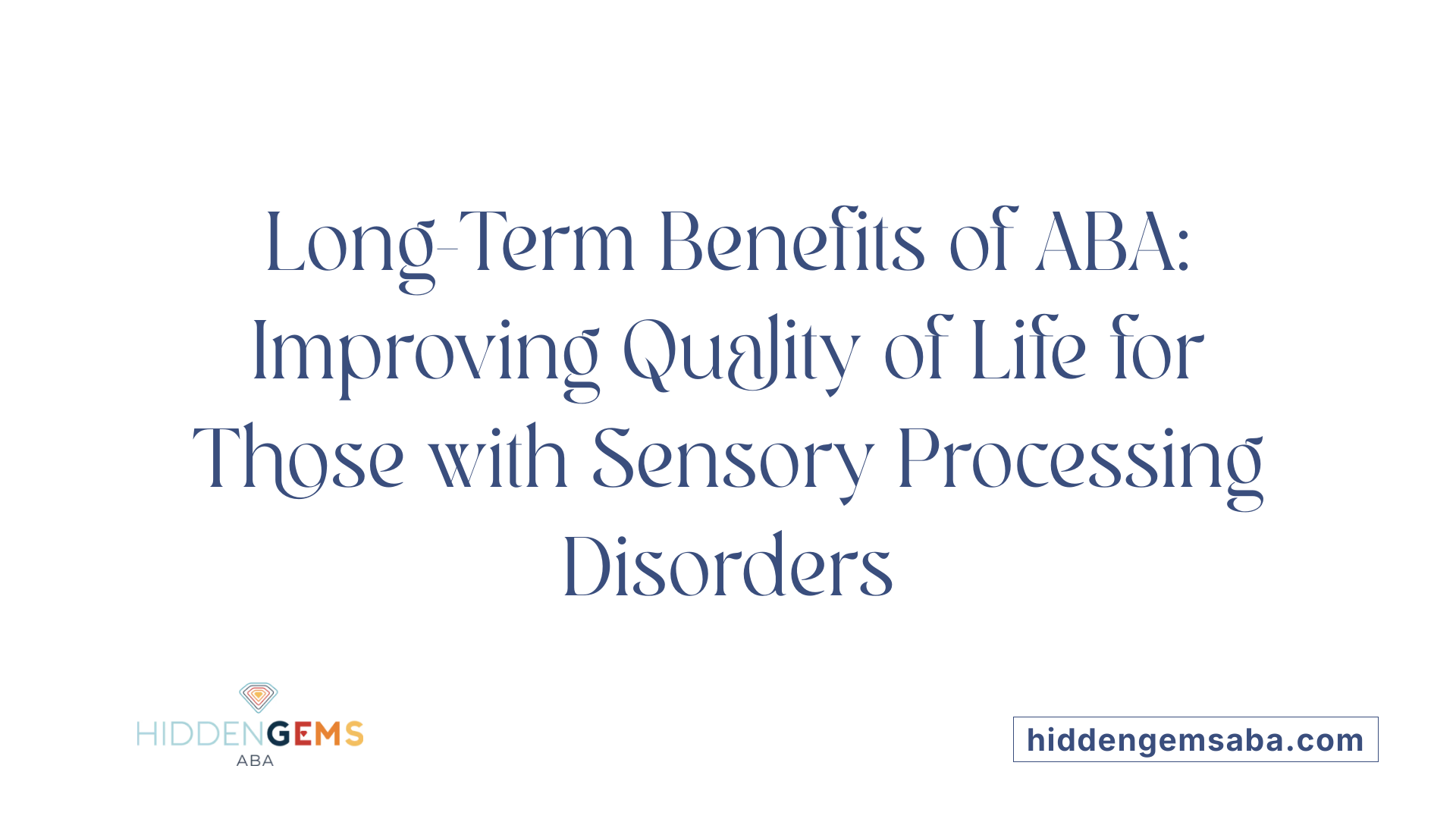Introduction to ABA and Sensory Processing Disorder
Applied Behavior Analysis (ABA) therapy, renowned for its effectiveness with autism spectrum disorders, also plays a vital role in addressing sensory processing difficulties. Sensory Processing Disorder (SPD) affects children's ability to respond appropriately to sensory stimuli, influencing behavior, emotional regulation, and social interactions. This article explores how ABA therapy benefits children with SPD by integrating behavioral strategies and sensory interventions to foster adaptive functioning and independence.
Understanding ABA Therapy: Foundations and Applications

What is Applied Behavior Analysis (ABA) therapy, and how does it help individuals with autism?
Applied Behavior Analysis (ABA) therapy is a scientifically based approach that focuses on understanding and modifying behavior through consistent observation and reinforcement. Rooted in the principles of learning and behavior, ABA analyzes behaviors by examining what happens before (antecedents) and after (consequences) an action—a concept often referred to as the ABC model.
ABA therapy is widely recognized as an effective treatment for individuals on the autism spectrum. It helps improve essential skills such as communication, social interaction, academic performance, and daily living activities. Through individualized programs, ABA targets the development of positive behaviors while reducing harmful or disruptive ones. Techniques include positive reinforcement, prompting, task analysis, and chaining behaviors, all designed to encourage repetition of desirable actions.
Principles of learning and behavior in ABA
The therapy works by carefully analyzing environmental factors that influence behavior. ABA professionals use detailed assessments to identify each individual’s needs and tailor interventions accordingly. Positive reinforcement—a method of rewarding desirable behavior—is a foundational tool that motivates learning and change.
By breaking down complex skills into smaller, manageable tasks, ABA facilitates gradual learning and mastery. This method allows therapists to teach new skills systematically while promoting independence. Additionally, ABA relies on structured settings which can be adapted to home, school, or community environments, ensuring that learning is generalized beyond therapy sessions.
ABA's role in autism treatment and broader applications
ABA is considered an evidence-based best practice by prominent organizations, including the US Surgeon General and the American Psychological Association. Intensive ABA therapy, typically ranging from 25 to 40 hours per week over one to three years, has demonstrated significant improvements in intellectual functioning, language development, social skills, and daily living for children with autism.
Beyond autism, ABA principles are also adapted to address other behavioral and developmental challenges. The flexibility of ABA methods makes it a powerful tool for various populations, focusing on fostering positive behaviors through scientific analysis and measured interventions.
In summary, ABA therapy harnesses the science of behavior to promote meaningful change, support skill development, and improve the overall quality of life for individuals with autism and beyond.
Qualifications and Roles of ABA Providers
Who provides ABA therapy, and what qualifications do these professionals typically have?
ABA therapy is delivered by specialized professionals, including Board Certified Behavior Analysts (BCBAs) and Registered Behavior Technicians (RBTs). These practitioners undergo extensive education, usually holding degrees in psychology, behavioral science, special education, or related fields. Further certification through the Behavior Analyst Certification Board (BACB) is essential, with the BCBA credential being the most recognized qualification for independent ABA practice.
Required education and certifications
Providers start with a bachelor’s or master’s degree followed by supervised practical experience in ABA. To become a BCBA, candidates must pass a rigorous exam ensuring mastery of behavioral principles, ethics, and intervention strategies. RBTs, who support BCBAs in implementing therapy, also receive formal training and certification that emphasize application of ABA techniques under supervision.
Professional standards and ethical considerations
ABA professionals are bound by stringent ethical guidelines to protect client welfare, ensure confidentiality, and maintain professionalism. Continuous education is mandatory to keep skills and knowledge up to date. Practices must comply with local licensing laws and create safe, supportive environments for therapy sessions. Overall, ABA providers are highly trained and committed to delivering ethical, evidence-based care tailored to the individual needs of clients.
Personalizing ABA Therapy for Sensory Processing Disorder

How is an ABA therapy program typically structured and personalized for each individual?
ABA therapy programs begin with a detailed assessment process, usually led by a Board Certified Behavior Analyst (BCBA). This initial evaluation includes Functional Behavior Assessments (FBAs) that help determine the nature of a child's behaviors and whether sensory processing issues contribute to those behaviors. Using this data, therapists identify the child's strengths and specific challenges.
Assessment procedures in ABA
Assessments focus not only on observable behaviors but also on how sensory stimuli might trigger or maintain those behaviors. For example, over-sensitivity to noise or touch may be closely monitored. This comprehensive understanding guides the choice of appropriate goals and interventions.
Individualized intervention planning
Following the assessment, a personalized ABA plan is developed for the child. This plan uses clear, measurable goals tailored to address both behavioral and sensory processing issues—such as improving tolerance to sensory input or teaching adaptive replacement behaviors. Goals often target communication, social skills, self-regulation, and daily living skills.
Tailoring ABA techniques to sensory behaviors
ABA strategies can be adapted by incorporating sensory integration methods like sensory diets, sensory play, and structured sensory activities. Techniques such as positive reinforcement and task analysis are used to teach replacement behaviors, like engaging with sensory toys instead of displaying disruptive reactions. Gradual desensitization helps children increase tolerance to overwhelming sensory stimuli.
Sessions incorporate discrete trial training, shaping, and scaffolding, with regular data collection to track progress. Environmental adjustments and sensory breaks are also included to support sensory regulation. Collaboration with families ensures activities and reinforcements align with a child’s interests, promoting engagement and skill generalization.
This tailored approach ensures therapy meets each child's unique sensory and behavioral needs, optimizing their ability to manage sensory challenges and succeed in various settings.
Integrating Sensory Integration Strategies into ABA

What are sensory processing challenges in children?
Children with sensory processing challenges may experience difficulties in receiving, interpreting, and reacting to sensory stimuli. This can manifest as hypersensitivity or hyposensitivity to touch, sound, light, balance, and body awareness. For instance, a child might cover their ears at normal sounds or seek intense movement. These challenges can affect emotional regulation, social interactions, behavior, and participation in daily activities. Sensory processing disorder (SPD) is common among children with autism spectrum disorder (ASD), with up to 95% affected.
How can sensory integration be combined with ABA principles?
Applied Behavior Analysis (ABA) focuses on modifying behavior using reinforcement strategies, while sensory integration therapy addresses the way children process sensory input. By combining these approaches, therapists can create individualized plans that break down sensory-related behaviors into measurable parts and address them effectively. This integration, often called sensory integration ABA, uses ABA techniques such as functional behavior assessments (FBA) to guide interventions and tailor sensory activities to each child’s unique sensory profile.
What are examples of sensory-based ABA interventions?
Sensory-based ABA strategies include:
- Positive reinforcement: Rewarding adaptive behaviors such as using sensory tools or wearing appropriate footwear.
- Task analysis and discrete trial training: Breaking down sensory tasks into smaller steps to teach tolerance gradually.
- Behavioral interventions: Using shaping and scaffolding to teach replacement behaviors like engaging with sensory toys instead of disruptive actions.
- Environmental modifications: Adjusting lighting, noise levels, and providing sensory breaks to reduce triggers.
Additionally, sensory integration activities may involve tactile play, vestibular exercises like swinging, proprioceptive input through heavy work, and auditory activities integrated within an ABA program. Such combined approaches aim to improve social engagement, emotional regulation, and independence for children with sensory processing challenges.
ABA Techniques to Address Sensory Behaviors
Positive reinforcement for sensory regulation
Applied Behavior Analysis (ABA) uses positive reinforcement to encourage adaptive sensory behaviors. For example, children may be rewarded for tolerating sensory stimuli that usually overwhelm them, such as wearing sensory-friendly shoes or using noise-canceling headphones. This reinforcement helps increase desirable behaviors like using sensory tools or engaging in calming sensory activities.
Behavioral interventions for sensory issues
ABA employs behavioral strategies such as shaping and scaffolding, where complex sensory behaviors are broken down into manageable steps. Task analysis guides children through these steps systematically, while differential reinforcement encourages replacing disruptive behaviors with more appropriate sensory responses. Teaching replacement behaviors is crucial; for instance, a child might be taught to play with a sensory toy instead of engaging in self-stimulatory actions.
Use of sensory breaks and environmental adjustments
Incorporating sensory breaks within ABA therapy provides children opportunities to regulate their sensory input, preventing overload. Therapists adjust environmental triggers by creating sensory-friendly surroundings that reduce stressors like bright lights and loud noises. Such adjustments, combined with scheduled sensory activities and breaks, enhance emotional regulation, social interaction, and learning outcomes for children with sensory processing challenges.
Collaborative Benefits of Combining ABA and Sensory Integration Therapy
Advantages of combining therapies
Combining Applied Behavior Analysis (ABA) and Sensory Integration Therapy offers a holistic approach that addresses both behavioral and sensory processing challenges in children, especially those with autism spectrum disorder (ASD). ABA focuses on behavior modification and reinforcement strategies, while Sensory Integration Therapy targets how the brain processes sensory information through tailored activities like sensory diets and physical exercises. Together, they provide a comprehensive plan that supports developmental goals across multiple areas.
Improved social engagement and emotional regulation
Integrating ABA and sensory approaches can significantly enhance social interactions and emotional regulation. ABA helps children develop communication and social skills through positive reinforcement and structured learning, while sensory integration therapy reduces sensory overload and helps children better interpret sensory signals. This collaboration often results in fewer problem behaviors, reduced anxiety, and greater emotional control, allowing children to participate more fully in social settings.
Comprehensive support for behavioral and sensory challenges
By combining these therapies, practitioners can create individualized intervention plans based on thorough assessments, including Functional Behavior Assessments (FBA) that identify sensory-related behaviors. ABA strategies such as teaching replacement behaviors, gradual desensitization, and sensory breaks complement sensory strategies like tactile or vestibular activities. This dual approach promotes independence, improves focus, and supports coping skills, empowering children to manage sensory stimuli and behaviors effectively across home, school, and community environments.
Practical Tools and Environmental Supports for Sensory Processing
Use of Sensory Toys and Sensory Diets
Sensory toys play a crucial role in helping children with sensory processing challenges regulate their responses to various stimuli. Items like textured balls, fidget spinners, noise-canceling headphones, and sensory beds provide targeted sensory input to calm or stimulate the child as needed. Sensory diets—a series of structured sensory activities integrated throughout the day—are specifically designed to help children maintain an optimal level of sensory arousal. These activities might include tactile play, auditory stimulation, or balanced movement exercises that can be incorporated at home or in therapy sessions.
Creating Sensory-Friendly Home Environments
A sensory-friendly home environment can significantly improve daily routines for children facing sensory difficulties. This includes setting up calm corners with adjustable lighting and soft furnishings, managing noise through soundproofing or headphones, and offering movement options like swings or exercise balls to meet proprioceptive and vestibular needs. Organization of spaces to reduce visual clutter, along with the strategic placement of sensory tools, helps children anticipate and manage sensory input effectively, reducing anxiety and meltdowns.
Supporting Independence Through Sensory Accommodations
Integrating sensory accommodations into daily life fosters independence and confidence in children. Practical supports, such as wearing appropriate footwear for sensory comfort or using sensory tools during tasks, encourage adaptive behaviors. Visual and auditory cues, relaxation techniques, and scheduled sensory breaks empower children to self-regulate their sensory experiences. These strategies, combined with ABA techniques like positive reinforcement, help children learn alternative responses and gradually tolerate challenging sensory inputs, enabling better social engagement and smoother participation in everyday activities.
Expected Outcomes and Long-Term Benefits of ABA for Sensory Processing Challenges

What improvements can families expect from ABA therapy for individuals with autism?
Families engaging in ABA therapy often see notable progress in communication, social interactions, behavioral regulation, and daily living independence. Skill development usually begins with foundational behaviors like maintaining eye contact, using gestures, and mastering basic self-care tasks. Over time, these skills expand to more complex activities including reading, cooking, and managing money.
The therapy is highly individualized, with outcomes shaped by each child's unique needs, the consistency of intervention, and family involvement. Early intervention plays a crucial role, as starting therapy at a young age and maintaining a sustained, data-driven approach often leads to substantial developmental gains.
How does ABA improve behavior and sensory regulation?
ABA applies reinforcement strategies to encourage desirable behaviors and gradually reduce disruptive ones. For children with sensory processing challenges, ABA integrates sensory integration techniques such as sensory diets and structured sensory activities. This combined approach supports better emotional regulation and helps children manage sensory stimuli that previously triggered meltdowns or avoidance.
Gradual desensitization through exposure and positive reinforcement enhances tolerance to overwhelming sensory inputs, assisting children in adapting to everyday environments more comfortably.
In what ways does ABA enhance daily functioning and social skills?
ABA therapy helps build essential life skills including attention, focus, social engagement, and self-care. By breaking down complex behaviors into smaller, manageable steps, children learn to participate more independently in daily activities at home, school, and in the community.
Improvements in social skills facilitated by ABA encourage meaningful peer interactions and reduce isolation. Sensory strategies incorporated within ABA further support children's ability to navigate sensory-rich environments, enhancing learning and social participation.
Role of early intervention and family involvement
Starting ABA therapy early and involving families deeply in the treatment process are fundamental for achieving lasting benefits. Family members contribute to generalizing skills across settings, providing consistency, and reinforcing positive behaviors daily.
Therapists often collaborate with families to create practical sensory-friendly home environments and integrate sensory activities into routines, which amplifies therapeutic gains.
Overall, ABA therapy coupled with sensory integration techniques offers children with sensory processing challenges a comprehensive path toward improved independence, better behavior management, and enriched social functioning.
Conclusion: Empowering Sensory Regulation Through ABA
Applied Behavior Analysis, when thoughtfully adapted to address sensory processing challenges, offers a promising therapeutic pathway for children with Sensory Processing Disorder. By combining rigorous behavioral principles with sensory integration strategies, ABA facilitates the development of self-regulation, social competence, and adaptive skills. Collaboration among skilled professionals, caregivers, and families ensures therapy is personalized and responsive to each child’s evolving needs. Ultimately, embracing ABA’s versatile approach can empower children with sensory processing difficulties to navigate their environments more comfortably and confidently, leading to improved quality of life and greater independence.
References
- All You Need to Know About ABA and Sensory Integration ...
- How ABA Supports Children with Sensory Issues?
- Sensory Integration Therapy for Autism
- Sensory Processing Disorder and Autism
- Applied Behavior Analysis (ABA)
- 4 Crucial ABA Clinic Requirements Checklist: What You Need ...
- What Progress Looks Like in ABA Therapy for Autism


.jpg)


